

2025 Christmas Luncheon |
THE SOCIETY'S GUEST SPEAKER IS Francisco "El Comanche" Gonzales OF "LOS COMANCHES de la Serna"
|
|
LECTURE FOR OCTOBER 4th, 2025 |
|
BILINGUAL
by Paulette Atencio |
|
"LA COSECHA"
by Will Jaremko |
|
NEW MEXICO RAILROAD'S by Fred Friedman
|
|
LECTURE FOR JUNE 7th 2025 |
|
ISAAC SLOVER by Tim Green
|
|
Isaac Slover and the Extranjeros in Taos (1820s and 1830s) |
|
"HONOREE LUNCHEON"
|
|
|
|
LECTURE FOR
APRIL 5th 2025 |
|
NUEVO MEXICO DEL NORTE: by Guadalupe Tafoya
|
|
Palace of the Governors, Santa Fe: Guest curator working on the Columbian Quincentennary, |
|
TCHS ANNUAL MEETING
|
|
"GROWING UP IN TAOS" JOSE GUSTAVO CORDOVA
|
|
CHRISTMAS LUNCHEON & SILENT AUCTION
|
|
|
|
TCHS LECTURE FOR NOVEMBER 2, 2024
|
|
|
|
|
|
TCHS LECTURE FOR
OCTOBER 5, 2024
|
|
By Maggie Duval
|
|
|
|
TCHS LECTURE FOR
SEPTEMBER 7, 2024 |
|
ARROYO HONDO ARRIBA LAND GRANT
by David Arguello, PhD, LCSW |
|
AUGUST 3, 2024
|
|
|
|
|
|
2024 HONOREE LUNCHEON Sunday, May 5th, 2024
|
|
Honoree:
Robin Martin, Chris Baker, Lynn Robinson, John Miller, Chris Wood, Mary Chavez Guest Speaker:
Martin Jagers,
|
|
|
|
TCHS LECTURE FOR APRIL, 2024 "TAOS COUNTY GEOLOGY"
|
|
Deborah A. Ragland, Ph.D. Adjunct Instructor of Geology,
|
|
|
|
"WHEN CIMARRON MEANT WILD" Saturday, March 2nd, 2024 |
|
|
|
CHRISTMAS LUNCHEON December 3rd, 2023 |
|
TCHS To Feature Theresa (Tessa) J. Cordova, Ph.D. "PASTORES"
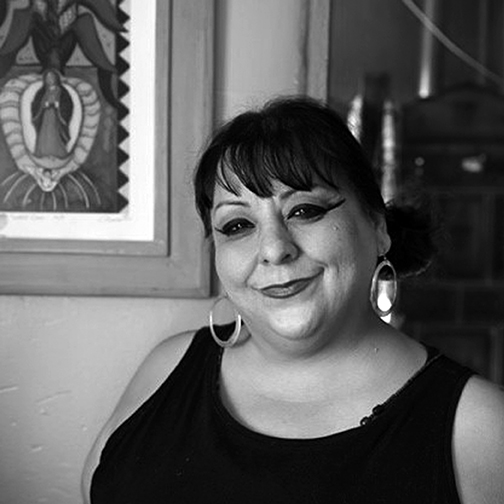
|
Independent scholar, Dr. Theresa J. Córdova earned a Ph.D. in American Studies at the University of New Mexico in 2012. She serves as the founder, director and curator of Las Pistoleras Instituto Cultural de Arte in El Prado, New Mexico. Las Pistoleras Instituto Cultural de Arte opened its doors in 2013 as a communal space where cultura, activism and the arts are at the forefront of community identity. Dr. Córdova also remains active in the continual mission of Sangre de Cristo Liturgies, an organization founded by her father, the late Arsenio Córdova in 1981. Sangre de Cristo Liturgies is devoted to the preservation and recovery of the history, traditions and culture of northern New Mexico and southern Colorado. Sangre de Cristo Liturgies fosters its mission through the use of theatre, music and lectures. Arsenio
|
|
|
"DESCANSOS" The Haunting Beauty of New Mexico's |
|
"THE LAND SHAPES THE PEOPLE" |
|
TAOS, N.M. –The Bureau of Land Management (BLM) Welcomes Eric Valencia as the Monument Manager for the Río Grande del Norte National Monument, located within the BLM Taos Field Office. Valencia will oversee 245,290 acres of multiple-use public lands within the monument that spans across Taos and Rio Arriba counties. The Taos Field Office is in the process of developing a Resource Management Plan for the monument and Valencia will assist in coordinating that effort. “We are delighted to grow our team. |
|
The BLM manages more than 245 million acres of public land located primarily in 12 western states, including Alaska, on behalf of the American people. The BLM also administers 700 million acres of sub-surface mineral estate throughout the nation. Our mission is to sustain the health, diversity, and productivity of America’s public lands for the use and enjoyment of present and future generations. |
|
THE DIXON SCHOOL CASE: August 5th, 2023 |
|
During the first half of the twentieth century, it was normal to find Catholic sisters dressed in their flowing religious garb teaching in public schools in New Mexico. Well over a hundred sisters taught in the state's education system at a given time; sister-taught schools were especially common in Taos County and neighboring Rio Arriba County. Seventy-five years ago, a small group of plaintiffs, many of them Presbyterian, sued to end this prac- tice. The "Dixon case", as their lawsuit became known, made headlines across the country. For a brief period following World War II, New Mexico and its "captive schools", as critics called them, took center stage in a fiery national debate about the power of the Catholic Church in the United States, and the shape of the principle of church-state separation. Dr. Holscher's talk will explore the local circumstances that made sister-taught public education the norm across northern New Mexico, as well as the role New Mexican communities played in defining church-state separation as an American legal principle during the twentieth century.
|
In my work I think about the relationship of religion, especially Catholicism, and formations of race and empire, particularly US settler colonialism. I am interested In how religious and colonial things have co-constituted one another, historically, and I am also interested in moments when religion is an opportunity for resistance. Religion and law (church-state relations) is one place I go to ask these questions- my first book was Re!igjous Lessons: catholic Sisters, Public Education and the Law jn Mjdcentury New Mexico {Oxford University Press, 2012). My recent work has dealt especially with Catholic clerical sexual abuse in the context of US "Indian missions"; I have published longer academic pieces on this, as well as shorter pieces online for journals like the National Catholic Reporter and The Revealer. This work has extended into to thinking about religious boarding schools and other residential facilities that managed Native youth. In the American Studies Department, I teach graduate seminars on Secularism and Empire and on Religion, Race, and Revolution, as well as undergraduate courses on Radical Religions & American Transformations and on Religion in New Mexico. I also teach courses on Catholicism, including on Catholic saints, in the religious studies program at UNM. |
TCHS HONOREE LUNCHEON May 7th, 2023 |
|
Professor Emeritus, Deacon Larry Torres is a native of Taos, New Mexico, where he was born in 1954. He has taught all levels of education and retired after 43 years in the classroom. He was professor of French, Russian, Spanish, Latin, Italian and Bilingual Education and retired from both Taos High School and UNM-Taos in 2018. Furthermore, he was a founding father of the School for International Studies in Memphis, Tennessee. |
"HARWOOD MUSEUM OF ART CENTENNIAL" March 4th, 2023 |
|
Taos County Historical Society presents early look at HarwoodMuseum's centennial celebrationsThere's a timelessness about the Taos Valley In advance of the Centennial kickoff in June, Ms. Leherissey's talk begins at 2 pm on |
Juniper Leherissey, Executive Director, has followed a passion for art and creativity back to her hometown of Taos. She spent many hours at the Harwood Public Library growing up. After dedicating her career to non-profit arts, Juniper took the helm of the museum in 2019 to make a difference in the community that she loves. With 26 years of professional non-profit management experience, she has held positions at the Carnegie Museum in Pittsburgh, Henry Art Gallery in Seattle, Santa Fe International Folk Art Market, Taos Land Trust, and other arts organizations. She was Development Director for the Harwood for 8 years prior to returning as Director. She holds a Masters in Arts Management from the Carnegie Mellon Heinz School of Public Policy and Management, and a Bachelor of Arts in Anthropology from Reed College. She serves on the governing boards of the New Mexico Humanities Council, STEMarts Lab, and the MAE Private Foundation. Juniper loves to cook, dance, and travel. She often helps with the acequia and gardening on the family farm. And, whenever possible, explores the beauty of New Mexico’s outdoors with her two boys and two dogs. |
TCHS ANNUAL MEETING Board Elections & "Growing Up In Taos" Lecture Saturday, February 4th, 2023
|
|
Guest Speaker: Growing up in Taos
|
Section V of TCHS By-laws require that Officers and Directors be elected at the Annual Business Meeting. Officer vacancies this year include: President, Secretary and three board members. Nomination Committee members met several times during December to conduct interviews for the vacant officer and board member positions. The committee recommends the following:
|
Saturday, November 5th, 2022 |
|
CAUTIVOS Y CRIADOS:
|
|
Saturday, October 1st, 2022 |
|
CHILDREN'S
|
|
|
|
Saturday, August 6th, 2022 |
|
B. C. Hernández: A Talk by Virginia Dodier
|
|
TCHS Honoree Luncheon - May 1st, 2022 |
|
HONORING |
|
Saturday, April 2nd, 2022 |
|
"Within These Solemn Walls" |
|
CHRISTMAS LUNCHEON Sunday, December 5th, 2021 |
|
TCHS To Feature Professor Emeritus,
Crossing the Camino Real:
|
The Taos County Historical Society is pleased to announce it’s Annual Christmas Luncheon. It will take place at The Sagebrush Inn on Sunday, December 5, 2021, at noon. This year, the attendees will be able to choose from any one of three lunch entrees. They will be able to select from among roast beef with mashed potatoes and vegetables, grilled salmon on rice with a pesto dressing, or enchiladas with southwest side dish trimmings. |
"New Mexico: The French Presence Since The 1500s" |
|
|
|
|
|
JEMEZ HISTORICAL SITE TOUR |
|
|
|
|
|
HONORING Guest Speaker: Vernon Brown |
|
STAR OF DAVID by Naomi Sandweiss |
|
|
|
"REFLECTIONS ON THREE TRAILS" by Rick Hendricks |
|
|
|
|
|
"OVER THE SANTA FE TRAIL by: Joy L. Poole |
|
|
|
|
|
"TIO VIVO" by: Wayne Rutherford
|
|
Wayne Rutherford moved to the Taos area in1978, living at first in a $35 per month three room adobe in Arroyo Seco. He has worked as a carpenter and mason and is an award-winning commercial & residential contractor with hundreds of large and small projects across north central New Mexico spanning 45 years. He has been a member of the Taos Lions Club since the early 1990's and is on his second stint as Chief Steward of the historic Tio Vivo Carousel. He is also the Historian-Archivist for this unique carousel. |
|
|
|
Featured Speaker: Frank Graziano
|
Frank Graziano is the recipient of numerous grants and fellowships from the Federal government, universities and foundations. Between 1996 and 2016 he was John R. MacArthur Professor of Hispanic Studies at Connecticut College. Frank Graziano has been an invited speaker at many institutions in the United States and abroad. His talk “Historic Churches of New Mexico” is an illustrated presentation with an overview of historic churches in the state and surveys themes pertinent to the churches’ current situation. The talk is based upon his research in villages, Indian pueblos, and archives for his recent book Historic Churches of New Mexico Today.
|
|
|
by Cindy Atkins
|
The Fechin House is one of Taos' true historical treasures. Cindy Atkins will provide a look into the factors of Nicolai Fechin (1881-1955) life that culminated in the creation of this masterpiece and offer a virtual “tour” of the home and its architectural details. Cindy Atkins' career includes decades of experience dealing with the public and providing exceptional customer service. In Taos, she worked as sales associate at Act I Gallery and at Chimayo Trading del Norte. Her volunteer activities include Treasurer and Board Member of the Taos Art Museum at Fechin House. Also, she served as its Interim Executive Director. Cindy is a member of the Taos County Historical Society and serves on the Board of Directors of the Taos Arts Council.
|
|
|
Doña Tules Barrelo by Van Ann Moore
|
|
|
|
|
|
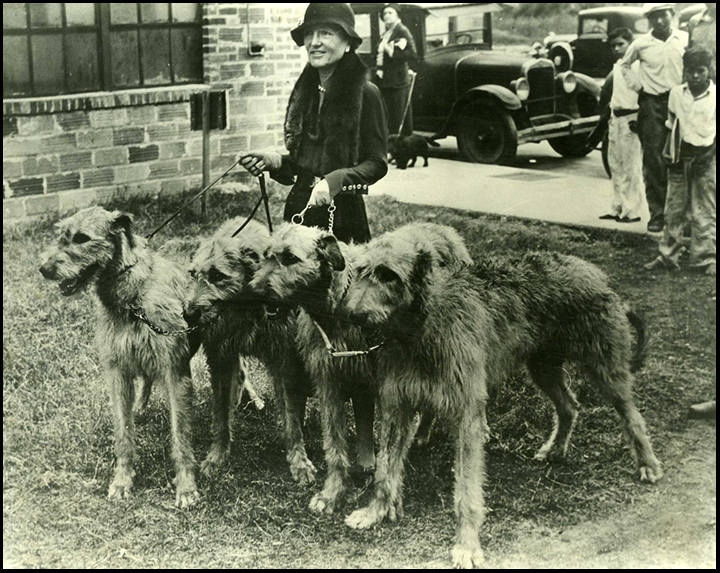
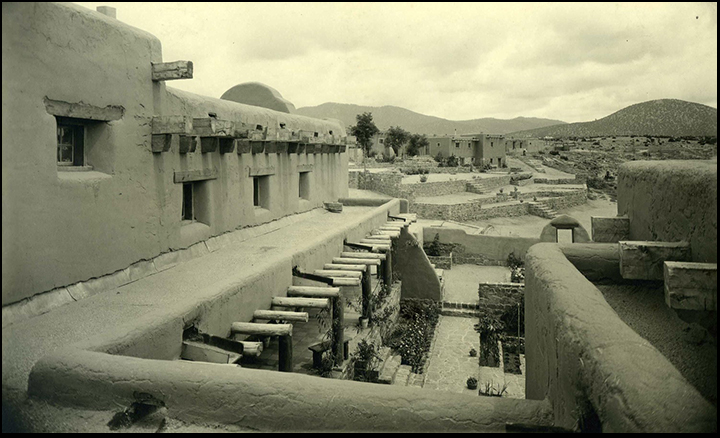
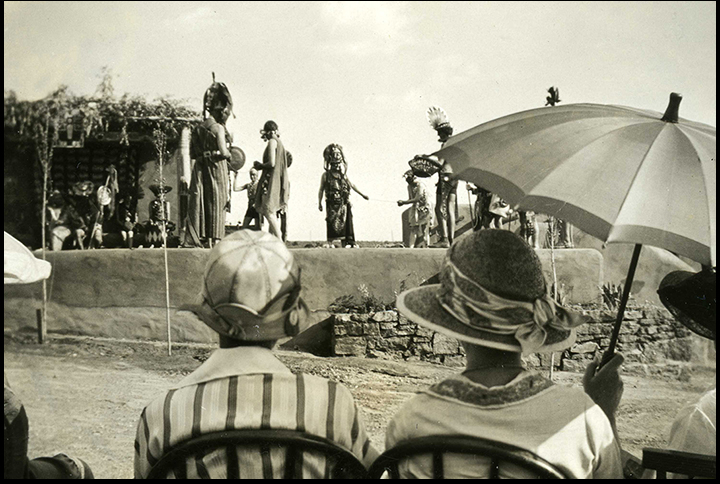
|
Scholar in Residence at School for Advanced Research, Santa Fe This lecture is sponsored, in part, by the Historical Society of New Mexico and its Speaker's Bureau. In the mid 1920's, Elizabeth White and her younger sister Martha came from New York City to Santa Fe, where they built a fabulous estate called El. Delirio or the Madness. It boasted a swimming pool and tennis courts, the first in Santa Fe, as well as a state-of-the-art kennel for their Irish wolfhounds and Afghans. Inspired by their education at Bryn Mawr College, the White sisters lobbied for the protection of Pueblo land, promoted Indian art and gave fabulous parties. They entertained numerous writers, such as Agatha Christie. Their enduring legacy, which includes Santa Fe's first animal shelter as well as their estate - bequeathed in 1972 to the School for Advanced Research - is examined in their illustrated presentation by Nancy Owen Lewis. Nancy Owen Lewis has a doctorate in anthropology from the University of Massachusetts and is currently a scholar-in-residence at the School for Advanced Research. She has conducted extensive research on the White sisters, as discussed in A Peculiar Alchemy: A Centennial History of SAR, co-authored with Kay Hagan (SAR Press). Her other publications include the award-winning Chasing the Cure in New Mexico: Tuberculosis and the Quest for Health (Museum of New Mexico Press). She has published five articles on the health seeker movement, including "High and Dry in New Mexico: Tuberculosis and the Quest for Health," which received the 2013 Gilberto Espinosa Award from the New Mexico Historical Review. She currently serves on the board of the Historic Santa Fe Foundation, is vice-president of the Historical Society of New Mexico, a member of the City of Santa Fe Public Safety Committee, and a fellow of the Society for Applied Anthropology. |
|
The Blumenschein Home
and Museum celebrates its centennial acquisition of its site
at 222 Ledoux Street by Ernest and Mary Blumenschein from "Buck"
Dunton. The family owned home turned museum was the Taos residence
of Ernest L. Blumenschein, Taos Society of Artists founder and
Their daughter Helen Blumenschein (1909-1989) gifted the family home in 1962 to the community and its Kit Carson Historic Museum now the Taos Historic Museums. In 1966 the building was placed on the National Historic Landmark Register. Helen was a avid amateur naturalist, historian, archaeologist and writer. She was a charter member of the Taos County Historical Society. Among her writings are Sounds andSights of Taos Valley, 1972 and Recuerdos and Early Days of the Blumenschein Family, 1979. Jeffrey Boyer was born and raised in Taos. His father, Jack Boyer, was instrumental in documenting, saving and restoring several of Taos' architectural treasures including the Hacienda de los Martinez. Jeff Boyer took his master's degree at the University of New Mexico and has worked on the archaeology of the northern Rio Grande since 1987 and was a project director of the New Mexico Office of Archaeological Studies. |
|
|
|
|
The illustrated lecture "Growing Up With Heroes: The Navajo Code Talkers of World War II" is presented by Zonnie Gorman, daughter of Code-Talker Carl Gorman. "Were it not for the Navajos, the Marines would never had taken Iwo Jima" Major Howard Conner, Signal Officer of the Navajos at Iwo Jima. The Marine Navajo Code Talkers played a vital role in the Pacific campaigns during World War II. They developed a code in their native language that baffled the Japanese and helped win American victory in the Pacific. "Growing Up With Heroes..." results from the 1989 personal journey by Zonnie Gorman to discover that part of her father's life, Carl Gorman, who was one of the original Navajo Code Talkers of World War II. Zonnie Gorman's research, interviews and archiving on the subject of Navajo Code Talkers and World War II created a touching and historical story about the First Twenty-Nine original code talkers. Her talk will include the Navajo Reservation of the 1940's, the U. S. Government policy of Assimilation and how the code was made. Zonnie Gorman conducted the first extensive interviews with the First Twenty-Nine Navajo Code Talkers and one of the Marine Corps recruiters involved with this critical operation. Zonnie Gorman is a recognized historian on the Navajo Code Talkers of World War II and has served as a consultant to numerous documentaries, museum exhibitions and magazine and book authors. She is the daughter of the late Dr. Carl Gorman: artist, teacher and one of the original "First Twenty-Nine" Navajo Code Talkers, the pilot group that devised the initial Navajo code. She is also the youngest sister to the legendary and renowned Navajo artist, the late R. C. Gorman. |
|
Zonnie holds a Master of Arts degree in history from the University of New Mexico and recently passed her PHD exams in the studies of History at UNM. Zonnie has also worked in Native American cultural tourism and the non-profit sector for over thirty years, She is currently a member of the Board of Directors for the Navajo Studies Conference. She is an alumna of Up With Peoples, Leadership McKinley, and Leadership New Mexico. She has received numerous awards over the years for her work in areas of cultural tourism, preservation and history.. |
|
|
|
|
May Honoree Luncheon |
12:00 Noon The Society's honorees are Gustavo Victor Goler, Santero and Art Conservator and Julia Moore, Co-editor of "Taos: A Topical History." The featured speaker is Estevan Rael-Galvez, Ph.D. and Principal of Creative Strategies 360 who will deliver a talk on the "Manitos Community Memory Project." Gustavo Victor Goler was raised in Santa Fe among a family of Latin American art conservators and restorers. Goler's early years were spent apprenticing in his family's conservation studios where he learned wood carving skills by helping conserve and restore 18th, 19th, and 20th century Saints from Latin America and New Mexico. Goler began carving Santos in high school as a hobby, creating a few pieces a year that he would give to family and friends. In 1986, he opened up a small conservation studio in Santa Fe where he specialized in the conservation of Santos. Julia Moore (1939-2019) graduated from Pomona College, California with a major in art history. She obtained an M.A. in Art History at NYU, Institute of Fine Arts and an M.L.S. in Library Science from Rutgers University. She was an editor at R.R. Bowker and was editor-in-chief at the Whitney Library of Design. Later, she was Director of Textbook Publishing at Harry N. Abrams, Inc. where she edited three editions of Jason's History of Art. Julia moved to Taos in 2004 and was a Board member of the Taos County Historical Society and a Board member of the Harwood Museum Alliance . Julia Moore collaborated with the late Corinna A. Santistevan to shape and edit the Society's award winning 2013 publication Taos: A Topical History. |
|
Dr. Rael-Galvez will speak on the "Manitos Community Memory Project" a northern New Mexico initiative to recover and revitalize cultural heritage. "Through the creation of community-based digital archives focused on the Indo-Hispano villages of Abiquiu, Amalia, Cerro, Chamisal, Costilla, Dixon, Las Trampas, Questa and Truchas, the project is redefining the meaning of community in a digital age. Manitos connects residents in villages with descendants of those who have moved away", states Dr. Rael-Galvez. New Mexico Highlands University, Department of Media Arts and Technology is the lead institution for the initiative which recently received a grant from the Andrew W. Mellon Foundation. |
|
|
|
|
Charles Randall has seen much in his life, all of as a member of the Taos community. He will be speaking on his recollections of growing up in Taos as a very active participant living, working and interacting in the community. The Randall family started the family business in Twining, now the Taos Ski Valley to supply building materials and dry goods to the gold miners in the area in the early 1900s. When the gold mining petered out, The Randall Brothers Hardware & Lumber business open a store in Taos in 1921, at the very location that Randall Lumber Company occupies now. Charles, along with his family, worked for the business and eventually he and his brothers ran the business started by his grandfather and father. The business remains in the family and is currently managed by his daughter Paula. Through the years, Charles has truly been an active participant in the Taos community by being a board member of several organizations, including the Kit Historic Museum and Taos Historic Museums, as well as serving as Master and Secretary of Bent Lodge 42 in the over 50 years he has been a member. He and the members of Bent Lodge in 1962 designed and built the Masonic Lodge on Camino de Santiago, which is still in use today. |
|
|
|
|
The names of New Mexico's places - its towns, mountains, streams, lakes, and much more - are as interesting and as colorful as the state itself. From Pie Town to Truth or Consequences to Tucumcari to the misspelled names of Albuquerque and itself... there is a story, sometimes colorful, but a story none-the-less. Bob Juylan is an Albuquerque-based author and speaker who specializes in New Mexico history and geography. He is the author of The Place Names of NewMexico, which describes the meanings and origins of New Mexico's named places. In this lively and often humorous talk he shares stories about these names and be available to answer many questions. Bob is also the author of The Mountains of New Mexico, and his first novel, Sweeney, won the 2012 Tony Hillerman Awardsof the Arizona-New Mexico Book Association.
Their Speakers Bureau program offers living history, performances and talks that are imaginative and accessible public programs that lead to a greater understanding of our human experiences and heritage. For additional information visit www.nmhum.org |
||
|
|
|||
|
Andrés Armijo is from Valencia, New Mexico, and was born to Rosemary Gallegos and Vincent C. Armijo, Jr. He earned both a bachelor's and a master's degree in Spanish with a concentration in Southwest Hispanic Studies from the University of New Mexico. He began his career teaching in the "Sabine R. Ulibarrí Spanish as a Heritage Language Program" at UNM. Andrés studied and performed flamenco dance for 12 years. He is the award-winning author of Becoming a Part of My History: Through Images & Stories of My Ancestors (Río Grande Books, 2010), and Por Constancia/So that it may be validated: Family History in the Río Abajo (Río Grande Books, 2014). This volume was awarded a New Mexico Historical Society award of 2015.
 |
|
|
|
Who are the Crypto-Jews? Why
are so many in New Mexico? This presentation by Norma Libman Norma Libman is a journalist and educator who has been researching the Crypto-Jews/Converso story for more than 20 years. She has interviewed at least 50 individuals and families in New Mexico and elsewhere and has lectured widely on the subject in the United States. In addition, she has published more than 500 articles on various subjects in newspapers nationwide. She is the author of the award-winning novel Lonely River Village. Ms. Libman is a member and speaker of the New Mexico Jewish Historical Society. |
|
Dr Bauer's celebrates the 50th anniversary of the Wild and Scenic Rivers Act by Congress. In the Society's seminal 2013 volume "Taos: A Topical History", Dr. Paul Bauer authored the article "Formative Epochs: The Origins and Evolution of the Taos Landscape". Editors Corina A. Santistevan and Julia Moore, in their introduction, wrote "The spectacular geography of Taos creates a setting unlike any other. Geologist Paul Bauer explains why and how today's land forms came to be and why the Taos Valley is one of the most dynamic landscapes on Earth. The geology of Taos has had and continues to have a profound influence on the peoples who have made Taos home." His 2011 award-winning book "The Rio Grande: A River Guide to the Geology and Landscapes of Northern New Mexico" provides detailed information on access trails, history and landscape and is an invaluable guide for both historians and casual visitors as well as whitewater ehnthusiastics. |
| Dr. Paul Bauer is a recently retired principal geologist and former associate director at the New Mexico Bureau of Geology & Mineral Resources at New Mexico Tech. He received a Ph.D. in geology from NM Tech in 1988. He subsequently served as manager of the state's Geologic Mapping Program for 12 years, and was program coordinator for the New Mexico Decision-Makers Field Conference for 10 years, a program designed to bridge the gap between earth scientists and policy makers. Since his first Taos Box trip in 1980, he has spent much of the last 30+ years investigating the geology and hydrogeology of north-central New Mexico,with an emphasis on the Taos County region. He has led many field trips to the area, including educational whitewater rafting tours. | |
|
Christine St. Vrain-Fischahs
(pronounced "fish-us") is a retired paralegal currently
living in Los Alamos, NM with her husband, dog, cat and two birds.
Every generation produces exceptional men and women that inspire us. In the 1800s, Ceran St. Vrain proved to be one of these unique men. He lived his adult life in the Southwest and left an enduring influence that can still be seen in the trail ruts, old centers of trade, and the mills he helped build - one of which still stands as a monument to his legacy. From fur trapping and trading, he made advancements in business, politics and military endeavors that established him as a leading pioneer of the early west. Join Christine St. Vrain-Fischahs as she takes us on a journey to the past to learn about the life of Ceran and discover the legacy he left behind. |
|
HONOREE LUNCHEON (Lecture Video) 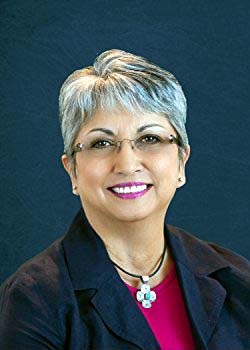 The featured speaker at the
Honoree Luncheon is Henrietta Martinez Christmas, genealogical
and historical researcher and New Mexico historian. The title
of her talk is Henrietta Martinez Christmas a native New Mexican is a well-known genealogical and historical researcher. She descends from eleven of the soldiers that came with Onate in 1598. She has written several books which relate to New Mexico's small towns and history and over 160 articles about New Mexico's Colonial families. She is a long-time member and current President of New Mexico Genealogical Society. She has worked with the History Museum of New Mexico, The Albuquerque Museum, The El Camino Real Heritage site in preparing exhibits and researching historical sites. She is a frequent contributor to author's book in terms of researching biographies of individuals. She works with a group that honors historic women in New Mexico for the NM Historic Marker Program. Honored by the DAR for historic preservation, she has extracted and transcribed over 50 books which consist of hundreds o thousands of records. Her latest award-winning book The Genealogy Checklist won two awards in 2017. Her talk "A History of Taos County thruogh Genealogy" examines the ususal and unusual events, landdowners, censue and timelines of Taos County to see how one is connected to the history of this area. |
|
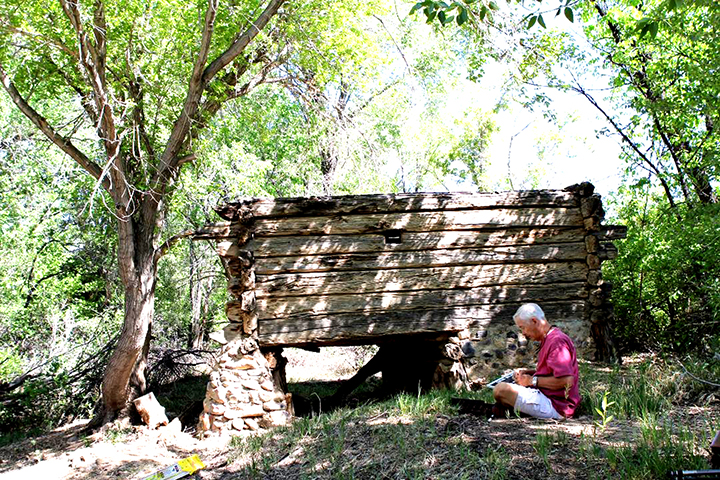 |
Charles (Corky) C. Hawk is a Colorado native with a lifelong interest in the history of the West. He received his BA in economics from Yale University and his Juris Doctor from the University of Michigan Law School. His special interest is pioneer roads and trails. He is a charter member of the Santa Fe Association and has studied historic trails in Wyoming, Colorado, Kansas and New Mexico. He contributed the essay "Camnios Antiguos: Trails Into the Taos Valley" for Taos: A Topical History Corky is a member of the Taos County Historical Society and served as a Board member and chair of the historic preservation committee. Corky is instrumental in the preservation of the Duran Molino. |
|
Conchita Thornton Marusich's lecture on her great-great-grandfather, William Wolfskill who was a trailblazer of the Santa Fe Trail in 1822 and the Old Spanish Trail in 1830. She will focus primarily on William's early life as a trapper and intrepid adventurer as he made his way from Missouri to Santa Fe and Taos before ultimately going on to California. Joined by her husband Rich, she will include interesting stories from their research travels when they retraced William Wolfskill's footsteps through Kentucky, Missouri, Kansas, Oklahoma, New Mexico, Utah, Nevada and California. They met William Wolfskill in his environment which meant going to where he had lived, trapped and traveled. Conchita Thornton Marusich has been interested in storytelling from a young age when her mother recounted tales about their ancestor, William Wolfskill, an important figure in early California history. Conchita Marusich worked as producer for Disney Educational Production and won numerous awards including CINE Golden Eagle. She also worked on shows for PBS, the Discovery Channel and the Home and Garden Channel. Conchita is a graduate of Vassar College and received her masters from Occidental College. She is a descendant of the Wolfskill, Lugo, De Pedrorena, Juarez and Estudillo families who settled in Alta California while it was still part of Mexico. Conchita is an active member of the Old Spanish Trail Association (OSTA) and is currently the president of the OSTA "Descendants and Travelers of the Trail" Chapter. |
|
|
|
|
Dr. Susan Boyle's presentation focuses upon the international network of trails in New Mexico both before and after 1821 with the opening of the Santa Fe Trail. Dr. Boyle will share the impact of trails on New Mexico society including an examination of New Mexican merchants like Felipe Chavez (1834-1906). Her talk explores what types of merchandise were part of the commerce and how these goods were transported along the 19th century. Susan Calafate Boyle received her doctorate in American Social History from the University of Missouri-Columbia. She has been a member of departments of history at several universities and colleges, a National Park Service employee, a Fulbright scholar in Argentina and a teacher for UNESCO sponsored post-graduate courses in Argentina. Dr. Boyle continues to work as an independent scholar focusing on socioeconomic developments in New Mexico during the 19th century as well as the history of El Rito, a small community in northern New Mexico's Rio Arriba County. Dr. Susan Boyle is the author of Los Capitalistas: Hispano Merchants and the Santa Fe Trail, Albuquerque, University of New Mexico Press, 1997. |
|
|
|
|
February 3, 2018
|
|||
|
The Taos County Historical Society will present a free, public program on "Not So Long Ago: Life in Pot Creek Lumber Mill Camps" by David Maes on Saturday, October 7, 2017, at 2:00pm in the Boardroom of Kit Carson Electric Cooperative, 118 Cruz Alta Rd., Taos, NM. This program is in collaboration with the Taos Arts and Cultural Consortium and its 2017 theme "Taos Stories and Legends." A tall, weathered, wood-frame
building sits a few yards back from the main road across from
SMU's Fort Burgwin main entrance. Today its sits alone and abandoned,
a far cry from its past glory days. It was the Administration
Building, the headquarters, for The Pot Creek Logging and Lumber
Company. Many lumbermen came from Arkansas and brought their families with them. They lived in several "camps" on the sawmill site. When the Lumber mill closed operations in 1965, many workers left Taos and moved back "home." A handful of young Pot Creekers married local folks and remained in Taos, raising families and putting down new roots. Today, the camps are gone and the logging trails grown over, but camp memories remain and will be shared at this Taos County Historical Society presentation. Several folks who grew up in the Lumber camps will participate in the presentation, sharing their memories. |
|
|
|
|
The intersection of Central Avenue
and Fourth Street in Albuquerque, New Mexico, is the only place
in America where U.S. Route 66 crossed itself. From its inception
in 1925, until a major realignment in 1937, Route 66 traveled
north from Santa Rosa, to Romeroville, just west of Las Vegas,
then on west to Santa Fe. From Santa Fe the road traveled south
over La Bajada, to Bernalillo and Albuquerque. From Albuquerque,
the road went further south to Los Lunas, where it turned west
to Laguna, then it resumed the east-west orientation to Grants
and Gallup. This presentation details the history of U.S. Route 66 through New Mexico, from 1925 to the present day. Baldwin G. Burr is the consulting historian at the Los Lunas Museum of Heritage and Arts and has earned a Bachelor of Arts degree in Art History at the University of New Mexico where he did graduate work in the History of Photography and Museum Practices at that same institution. In addition, he holds a Master of Arts degree in Education. He is the author of Images of America: Los Lunas, and Images of America: Socorro, published by Arcadia Publishing. His book, Images of America: Belen, won the 2014 New Mexico-Arizona Book Award for History. His current book project is The Historic Ranches of Northeastern New Mexico, to be published by Arcadia Publishing. |
|
|
|
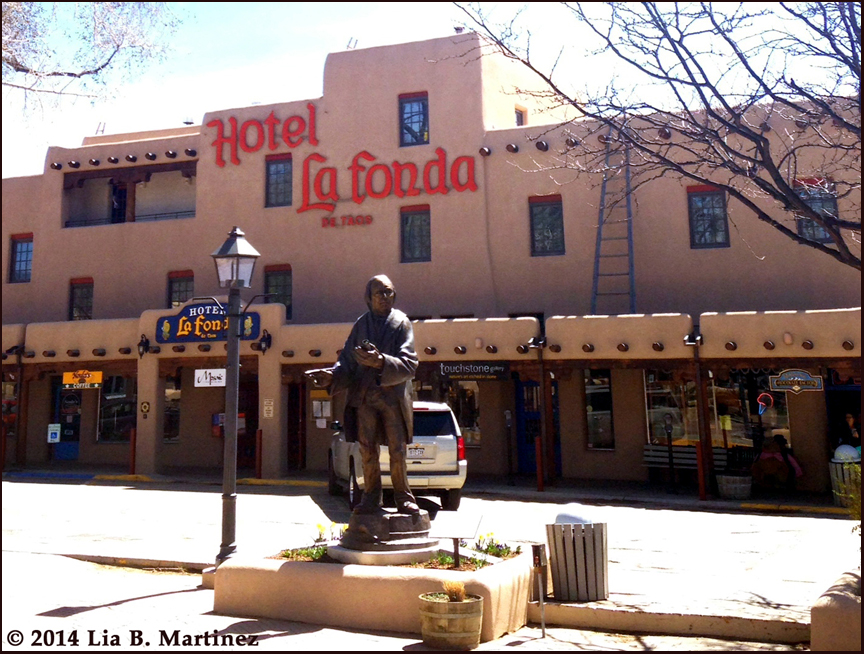
|
|
|
|
|
Brigadier General David A.
Torres welcomes the members of the Taos County Historical Society
and their guests on July 8, 2017, at 10:00am for an introduction
to the deep roots and family history of the Hacienda de los Torres
in Arroyo Seco. David Torres is the grandson of Jose Onesimo Valetine “O.V.” Torres who built the hacienda in 1914. Anna and OV had 11 children, all born at the hacienda. The original house is described as an American four-square plan house. It was about 1,500 square feet and had a 40 foot well dug by hand near the house. Beginning in the 1920s an orchard of apples, cherry, pears and peach trees was planted. By the 1930s, Torres owned more than 200 acres in El Salto and eventually became one of the largest land owners in Taos County with property in Tres Piedras and Chama. A 1940s homestead cabin, builtin Tres Piedras in 1918 to house shepherds, was moved to the hacienda in the 1980s. |
|
Today the hacienda covers 55 acres and has evolved to meet the needs of the family. The property has been recognized as historically significant due to its continued use as a ranch, its association with O.V. Torres and the sheep ranching industry in the state-- as well as, its use of the Acequia Madre del Rio Lucero for irrigation. The hacienda was named to the New Mexico State Registry of Cultural Properties in 1999. David Torres is the eldest son of the late Louis O. Torres and Bernice Torres of El Salto. He has a degree in Mechanical Engineering from the University of New Mexico, an MBA from Pepperdine University and a Master's of Science in Strategic Planning from the United States Air War College. He began his engineering career as an aerospace engineer working for NASA and Northrop Corporation. He is an Assistant Adjutant General for the New Mexico National Guard and a Trustee for Kit Carson Electric Cooperative, Inc. He continues to work as a humanitarian, first responder around the world. Torres has responded to over 30 international disasters around the world and was one of the first Americans on the ground for the 2014 ebola breakout in Liberia. He is married to Kristen K. (Vasko) Torres of Reno, NV and has two children in college. |
|
|
The people of the American Southwest have a rich cultural heritage that dates back hundreds of years. The program "Pueblo Lifeways and Traditions" will focus on the Pueblo People, and more specifically, the Jemez People. Our speaker Marlon Magdalena begins with an orientation on Pueblo languages and cultures before delving into this own experiences as a Jemez Pueblo tribal member. Artifacts and replicas will be utilized to dicuss their usage and meaning in Pueblo Culture, while also explaining the reason why some Pueblo Peoples do not indulge in the sharing of cultural knowledge with "outsiders." In recognition of the Taos High and Middle School cross-country running accomplishments, Marlon will share the long tradition of running that dates back to the time before modern convenyances like cars ever existed. Runners were used as messengers to carry news to neighboring villages. Even in modern times running is a very important spiritual ritual and way of prayer. The local history of running will be expanded with Marlon's own experiences as a descendant of runners and as a runner himself. Marlon Magdalena is the Instructional Coordinator for the Jemez Historic Site located in Jemez Springs, NM. He is in charge of educating the public about Jemez history and other Native American related topics. Marlon is a Jemez Pueblo tribal member and resident. He is also a flute maker and performer. |
|
|
|
|
Barbara Brenner's talk will not be purely academic, but a short biographical piece colored with his paintings and life. Her grandfather was a modest man and often claimed that people would probably mistake him for an "Undertaker". His humor and continued efforts to make Taos a better place were well known among Taosenos. Barbara Brenner was born and raised in Taos at a time when all the "founding" artists were still alive and working in Taos. She had the good fortune to know all of them, although for some she has childhood memories. Oscar Berninghaus (1874-1952) was an American artist, born in St. Louis, Missouri and a founding member of the Taos Society of Artists. He is best known for his paintings of Native Americans, New Mexico and the American Southwest. Although Berninghaus had little formal training his natural abilities and continued efforts culminated in many awards such as the St. Louis Artist's Guild prize (1924) for his painting Autumn Days and numerous commissions for murals like the Missouri State Capitol, Fort Scott, Kansas post office and others. Beyond his role with the Taos Society of Artists (1915-1927), he was a member of many art ogranizations including the National Academy of Design, New York, NY, the Salmagundi Club, New York, NY. |
|
Barbara Brenner was educated at the Brownmoor School and holds a B.A. from Colorado College. In 1985,she researched, edited and published a book on Oscar Berninghaus. The Taos County Historical Society presents its monthly, free, pubic program "My Grandpa Painted Pictures" by Barbara Brandenburg Brenner on Saturday, March 4, 2017, at 2:00pm in the Kit Carson Electric Cooperative Board Room, 118 Cruz Alta Rd., Taos. Barbara Brandenburg Brenner is the the granddaughter of Oscar E. Berninnghaus a founding member of the famed Taos Society of Artists. The lecture is in collaboration with the Taos Art and Cultural Consoritum 2017 theme "Taos Stories and Legends". |
|
|
Mirabai Starr is the author of the long-anticipated memoir, CARAVAN OF NO DESPAIR: A Memoir of Loss and Transformation. In her critically acclaimed new translations of the mystics and reflections on the unifying teachings at the heart of all spiritual paths, Mirabai uses fresh, lyrical language to help make timeless wisdom accessible to a contemporary circle of seekers. Daughter of the counter-culture, Mirabai was born in New York in 1961 to secular Jewish parents who rejected the patriarchy of institutionalized religion. Intellectual artists and advocates of social justice and environmental responsibility, Mirabai's family was active in the anti-war protest movement of the Vietnam era. In 1972, Mirabai's mother, father, and her younger brother and sister uprooted from their suburban life and embarked on an extended road trip that led them through the jungles of Mexico's Yucatan Peninsula, where they lived for many months on an isolated Caribbean beach, and ended in the mountains of Taos, New Mexico. There, the family embraced an alternative, "back- to-the-land" lifestyle, in a communal effort to live simply and sustainably, values that remain important to Mirabai to this day. As a teenager, Mirabai lived at the Lama Foundation, an intentional spiritual community that has honored all the world's faith traditions since its inception in 1967. This ecumenical experience became formative in the universal quality that has infused Mirabai's work ever since. |
|
|
|
|
The women in Women Marked for History are educators, writers, entertainers, activists, heroes (military and otherwise), community and society leadrs, political and government leaders, artists, scientists, historians and cultural preservationists, healers and other medical professionals and business leaders. The lecture will share the stoires of those who wove the fabric of what has become known as “The Land of Enchanment” and how these women intersect in so many interesting and unusual ways. “We are delighted to partner with the Archuletas and their book and the New Mexico Roadside Markers that honor women leaders to celebrate March, Women's History Month” says Ernestina Cordova, President, Taos County Historical Society. For example, in Taos County, on Route 150 to the Taos Ski Valley, there is a New Mexico Historic Women Marker honoring Virgina T. Romero. The daugther of Jose Pablo and Yeodorita Martinez, Virginia (1896-1998) was born at Taos Pablo. Virginia T. Romero a world famous potter and mother of ten children began her lifelong career in 1918. She supported her family by selling a variety of pots to locals and tourists for use in cooking, storing water and as decorative art. She helped keep the micaceous pottery tradition alive in Taos Pueblo. Traditionally, fired outdoors, these pots are dotted with flecks of mica, a shiny silicate mineral. Phil Archuleta is a native New Mexican born in El Rito. Since 1970 he has been involved with the manufacturing of the New Mexico Historical Markers and has traveled the state logging each marker in order to preserve this aspect of New Mexico history. Rosanne Roberts Archuleta was born in Philadelphia and like so many of the women in the book fell in love with New Mexico. The book, Women Marked for History she and Phil authored has created great buzz by filling in the details on the stories of behind the name of so many women honored with historical markers. |
|
|
|
|
Free Public Lecture Food of Dia de los Muertos By Deborah Gallagher 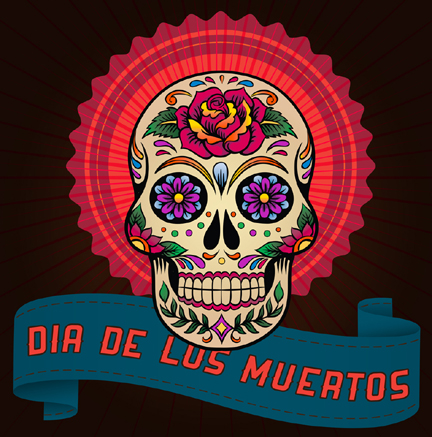 |
El Dia de los Muertos (the Day of the Dead) is by far the most significant of the calendrical festivals in the Southwest. El Dia de los Muertos is a time for families of the deceased to commemorate the dead. This day is set aside to commune with ancestors through the serving of a symbolic meal, and to tend to the grave sites of ancestors. Family members will clean and decorate the graves of their ancestors during the day and then return to local cemeteries after dark, carrying the favorite foods of the deceased for a shared meal and a system of offerings. Ms Gallagher will introduce the foods associated with Day of the Dead with brief remarks. She will also provide samples for tasting followed by questions. Deborah Gallagher is the owner of Tastes Catering. She came to Taos in 2000 and immediately became interested in the local culinary scene. |
|
She has taught at the Taos Cooking School, the Culinary Department at UNM, the Taos Public Schools and the Lifelong Learning Program in the Boulder Valley School District in Boulder, CO. |
|
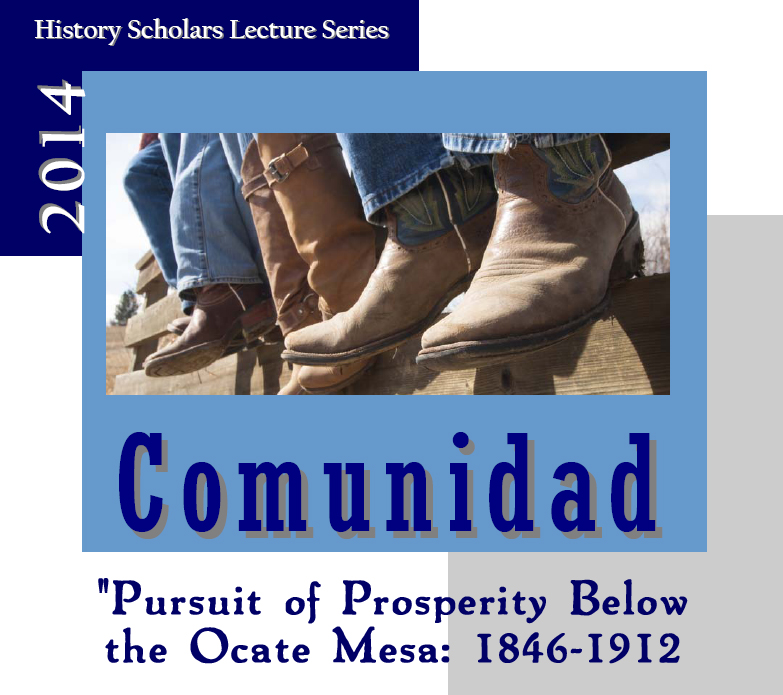 Presented by Derek LeFebre Presented by Derek LeFebreHistorical Society of New Mexico Office of the State Historian |
University of Northern Colorado graduate student Derek LeFebre recently won a scholarship through the Office of the State Historian in New Mexico and a separate award for emerging scholars from the Historical Society of New Mexico. The scholarship and the society's Myra Ellen Jenkins Award recognized LeFebre for his in-progress research, as part of his master's thesis, on interactions between New Mexicans, Indians and Anglo fur trappers from 1846 to 1912. He became interested in exploring the social, political and economic history of the northern New Mexico communities of Guadalupita and Ocate after learning through genealogical research that his ancestors were among the first wave of families that settled there during the American occupation of the region in 1846. What appeared to be a genealogy project became academic research, and inspired LeFebre to enroll at UNC, to tie his work to the "broader U.S. narrative" and answering questions about relationships between multiple cultures. |
|
In addition to oral family
histories, LeFebre is sifting through county and state public
documents to "enhance background knowledge of individual
settlers as well as events contributing to the historical context
of these communities in the territorial period." LeFebre studies history at UNC and has taught in Greeley-Evans School District 6 since 2006. He will teach social studies this fall at Greeley's new dual-language school, Salida del Sol Academy. His research is titled, "Pursuit of Prosperity below the Ocate Mesa, 1846-1912." |
|
Free Public Lecture The Taos Fiesta: Community, Memory, and Return to Center By Sylvia Rodriguez 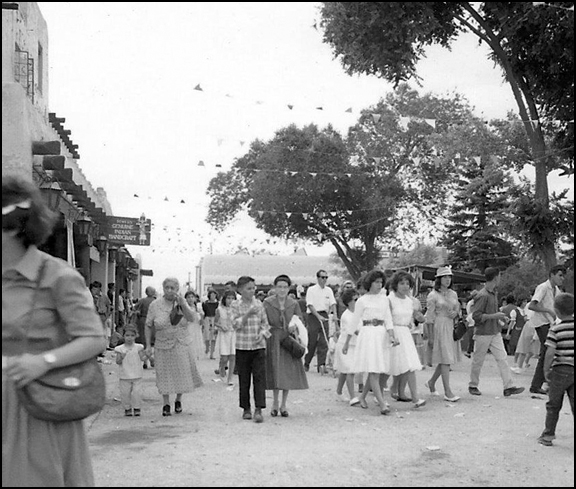 |
|
|
Program Speaker Larry Torres is a native of Arroyo Seco and has been a teacher of Spanish, Russian, French, English, Latin, Southwest Studies, Linguistics and Bilingual Education for the past 30 years. He currently teachers at UNM-Taos where he is Assistant Professor of Foreign Languages. Larry Torres is internationally recognized as a speaker and presenter in the field of Global Education in foreign language teaching. Mr. Torres is a writer whose work on New Mexico Hispanic culture has touched thousands by way of the Spanish page n the El Crepusculo section of the weekly Taos News. Larry's weekly article for the Taos News, "Cnautitio" is widely read and enjoyed by Taosenos. His essays have been compiled into several books and numerous awards recognize his accomplishments in education from private industry to state department of education and national societies. |
|
Free Public Lecture Rural Historic Landmarks of the Cañon Community By Shannon L. Papin of Community Bond Preservation  |
The Canon rural landscape is a traditional Indo-Hispanic agrarian community that comprises approximately 650 acres in Taos Valley. First settled by ancestral Puebloan people, the Spanish arrived in Taos Valley in the 1500's and settlement expanded with an increased acequia system and population growth. Settlement pattern followed as series of placitas on the sides of the Rio Fernando. Today, the area retains its agrarian identify with numerous small scale farms and two active acequias. Ms. Papin will address this historic background and present findings on buildings such as Our Lady of Sorrows (c.1830), the Old Taos Guesthouse (c.1820) and many others. She will also share history about Canon's structures and sites like Molino gristmill on Rio de Fernando and numerous pastures and orchards. Shannon L. Papin has over 15 years of professional experience in history, architectural history, historic preservation, heritage tourism and cultural resource. She has worked at the local, state and federal levels and has played a lead role in advocacy for preservation issues on a national level. Her rich and varied work history offers a broad perspective on historic preservation projects. Her recent work has focused on the identification, documentation and evaluation of historic resources including architectural survey, historic structure reports, Historic American Buildings reports and National Register nominations. She has worked on numerous reconnaissance level architectural surveys in DC, Maryland and New Mexico. Ms. Papin has served as the consulting historian on urban and master plans for communities and neighborhoods throughout New Mexico. She has done numerous public presentations of findings and has spoken at state and national conferences including National Main Street Conference and National Alliance of Preservation Commission Conference. Common Bond Preservation is a full service woman-owned cultural resource consulting firm specializing in architectural history and and historic preservation for communities and organizations in the Southwest and throughout the nation. |
|
|
|
|